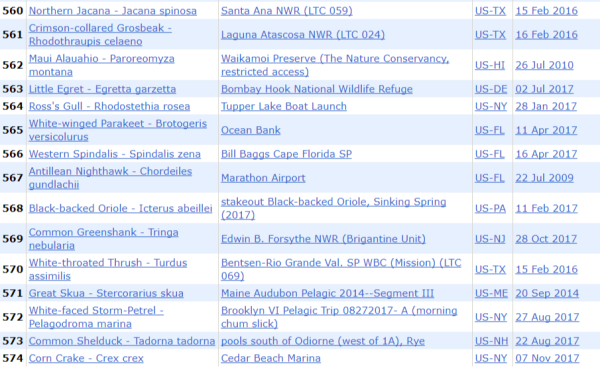Birding often requires a great deal planning and practice, especially when the goal is to find or chase rarities. The more you know, the more you get to see. I like to keep my various lists, read historical data, and pore over the finer points of challenging IDs to improve my fieldcraft. In general, I work hard to be prepared for anything. However, I love it when a spontaneous, completely unexpected discovery comes out of nowhere and rocks my world. Rare bird alerts, by nature, are full of surprises, but I was totally floored when I opened my email on an otherwise ordinary day to see a fateful message from Ken and Sue Feustel.
“A Corn Crake (this is no joke) is currently feeding on the north shoulder of the Ocean Parkway east of the Cedar Beach marina.” Never before has my inbox been graced by a report so incredible that the messenger felt obligated to announce that they weren’t pulling an elaborate prank. This species is a particularly enigmatic member of the ever-secretive rail family. Most rallids are difficult to locate even in areas where they are abundant, though many are known to migrate and wander long distances. These journeys sometimes bring them to unexpected places, and this bird was very far from home. Corn Crakes breed in Eurasian meadows, spending the winter in southern Africa. There are several North American records of individuals who got lost on this long-distance flight and wound up on the wrong continent, but the vast majority of these are over 100 years old. Very few individuals have been seen here in recent history, mostly consisting of specimens provided by hunters and cats. A handful of others were identified or announced too late for followup. One Newfoundland record was seen by only “half a dozen” birders before disappearing forever. There has never really been a properly chaseable Corn Crake in this hemisphere, certainly not since the dawn of modern birding. Until now.
I was in turmoil from the moment I read the email. I could not, would not miss this bird. Leave it to the once-in-a-lifetime vagrant to show up during the work week! At my first opportunity, I rushed homewards. Miriam, my fearless and endlessly supportive co-pilot, met me at the train station with her binoculars and camera so we could save precious minutes of remaining daylight. We made our way south to the Jones Beach barrier island and headed east. Brendan, Taylor, Shai, Mike, and dozens of other birders had already seen the crake over the course of the day. I was assured that he had been fairly cooperative, moving in and out of cover as it worked the brushy edge of the lawn beside the parkway. When we finally arrived at the stakeout, folks returning to their cars flashed smiles and thumbs up in our direction. I led the charge to the westbound roadside, and it wasn’t long before the mega-rare bird emerged from hiding.
The Corn Crake was quite unlike anything else I’ve seen before. Although its form was broadly reminiscent of Soras and other related birds, its relatively large size and sturdier structure set it apart. The intricate patterns of black and brown feathers on its back provided camouflage among the tangles but looked absolutely stunning in the open. Its intentional, deliberate gait and low-slung posture were unfamiliar and un-birdlike, though it looked more classically avian when it perked up like a periscope or darted roadrunner-style into the bushes.
In addition to being an unusual and interesting bird, this is easily one of the rarest creatures I will ever see in the Western Hemisphere. With the near absence of records outside the era of shotgun ornithology, I would guess that fewer than a dozen birders had observed a Corn Crake in North America before this report. The incredibly low rate of detection is certainly compounded by the bird’s inherently furtive habits. As a result, most ABA listers wouldn’t include it on even their wildest wishlists. It’s not really “on the radar” as something to watch for, being totally absent from the esteemed Sibley Guide and most other American birding resources. Sorting my United States life list by frequency on eBird (since North America and the ABA area cannot be sorted this way) the Corn Crake has now unseated even the Shelduck as the Mega of Megas. Best of all, it comes largely free of the provenance controversy that surrounds exotic waterfowl and cagebird candidates!

The high quality of this bird and the way its discovery blindsided me add up to one of the most memorable sagas of my birding career thus far. I expect that I’ll look back on our successful chase as a lifelong hobby highlight. My most profuse thanks to Ken and Sue for rapidly getting the word out on their truly remarkable find, and special shoutouts to the other birders who got to enjoy the crake and help keep tabs on it. What a mindblowing, unforgettable experience!
Year List Update, November 7 – 398 Species (+ Corn Crake)







Pingback: 2017 Top 10 Lifers | Studying Life
Pingback: Black-chinned Hummingbird at Randall's Island: the Community Discovery of a State First by Tim Healy | Nemesis Bird